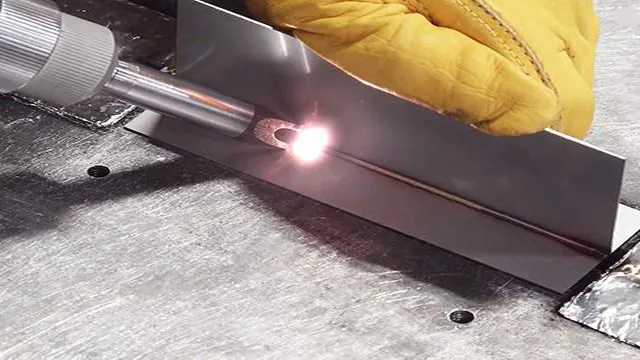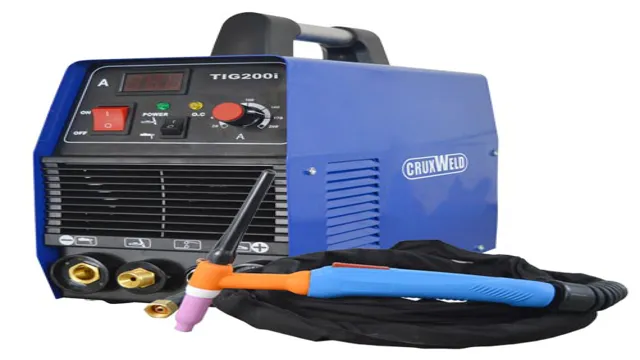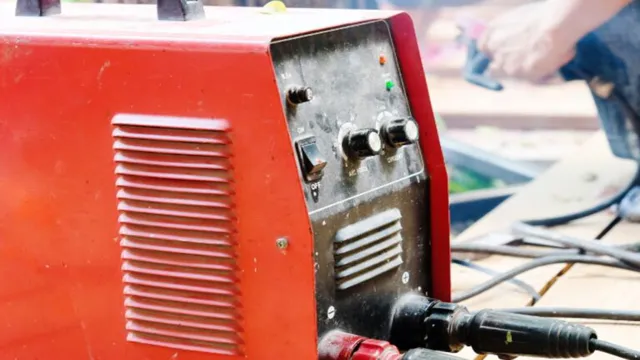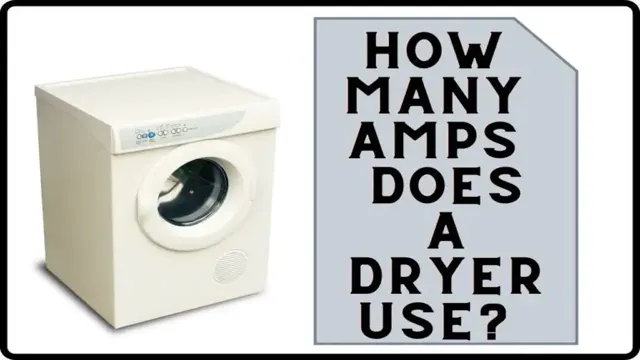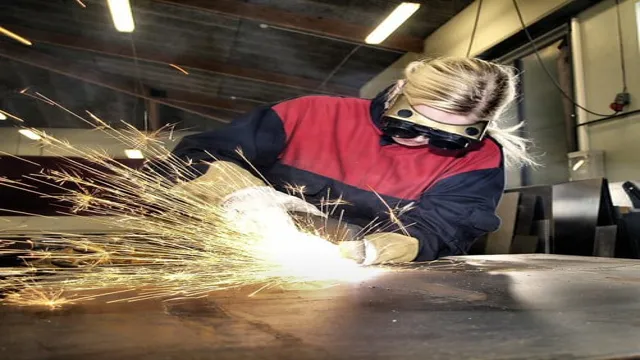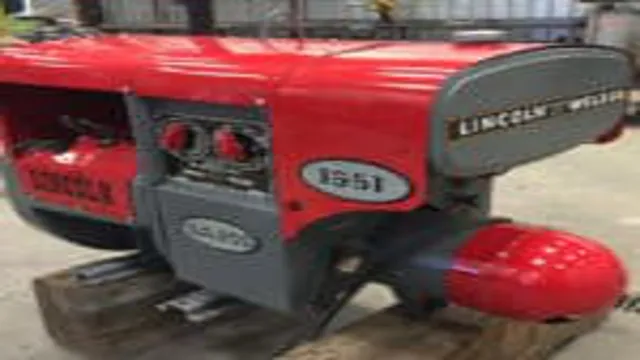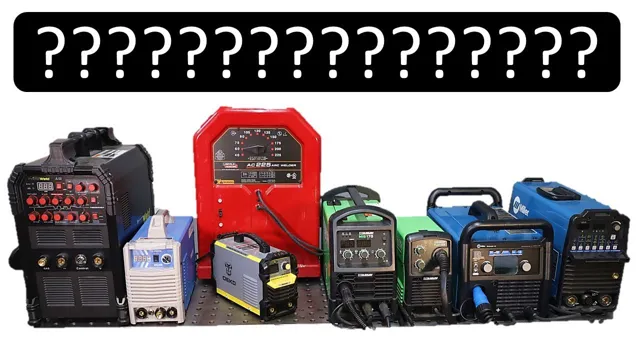How Arc Welding Machine Works: Understanding the Process and Techniques
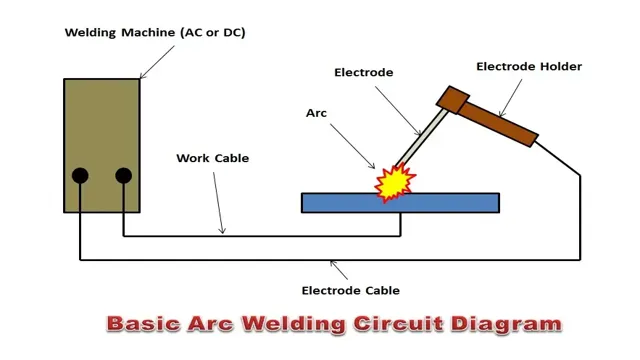
Arc welding is a widely used welding technique that has become an essential skill for many welders. This technique uses an electric arc to create heat, which then melts the metal and fuses it together. Welding machines that use this technique are incredibly complex, and many people often wonder how they work.
If you’re curious about the inner workings of an arc welding machine, you’ve come to the right place. In this blog post, we’ll break down the various components of an arc welding machine, how it produces an electric arc, and the various welding techniques used with this machine. So, grab a cup of coffee and settle in as we dive deep into the world of arc welding machines.
Overview
If you’ve ever wondered how an arc welding machine works, you’re not alone. Essentially, an arc welding machine harnesses the power of electricity to create a high-intensity arc between a metal object and an electrode or welding rod. This arc generates heat, which melts the metal and allows it to fuse with the welding rod or adjacent metal pieces.
The welding rod typically serves as a filler material, allowing welders to join two separate metal pieces together. The machine itself requires a reliable power source, typically either direct current (DC) or alternating current (AC). In addition, it must maintain a constant voltage and be able to adjust the amperage to suit the thickness and type of metal being welded.
Overall, arc welding machines are powerful tools that require skill, training, and safety precautions to use effectively.
What is Arc Welding?
Arc welding is a popular welding process that uses an electrical power supply to create an electric arc between an electrode and the workpiece. This arc melts the base metal and the electrode, resulting in a fusion of the two materials. The process is commonly used in the manufacturing and construction industries to join metal parts, repair structures or fabricate metal products.
The term “arc welding” is used to describe any type of welding that uses an electric arc as the heat source. The process requires a steady hand and a good understanding of safety protocols to prevent burns and other injuries. The filler metal used in arc welding can be made of a variety of materials including stainless steel, aluminum, and copper alloys.
Regardless of the material being welded, arc welding is a versatile and effective method for joining metal parts.
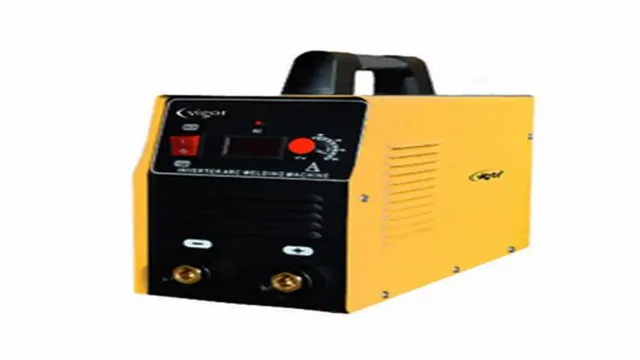
Components of an Arc Welding Machine
Arc welding machines are essential tools for welding and fabricating metal components. It is composed of various electrical and mechanical components that work together to produce an electric arc between the welding electrode and the workpiece. The components of an arc welding machine include a power source, electrode holder, cables, welding helmet, and a welding table.
The power source is the heart of the machine and provides the electrical current necessary to create an arc. The electrode holder holds the welding electrode and transfers the electrical current to the workpiece. The cables connect the power source to the electrode holder and the workpiece.
The welding helmet is worn to protect the welder’s eyes and face from the bright light and sparks produced during welding. The welding table provides a stable and secure work surface for the workpiece during welding. Understanding the components of an arc welding machine is crucial in selecting the right equipment for the job and ensuring safe and efficient welding operations.
Types of Arc Welding Machines
Arc welding machines come in various forms, each designed for specific welding tasks. The most common types include stick welders, TIG welders, and MIG welders. Stick welders, also known as shielded metal arc welding machines, are the simplest type of arc welding machines, primarily used for outdoors welding activities.
TIG welders, on the other hand, produce high-quality, precise welds and are often used for welding thin metals, such as aluminum. Lastly, MIG welders are the most versatile types of arc welding machines and are commonly used in automotive, manufacturing, and repair industries. These machines use a continuous wire feed, which melts and joins metals together.
Understanding the different types of arc welding machines is important before choosing the right welding machine. Each type has its advantages and disadvantages, and choosing the right one will depend on the job requirements.
Working of an Arc Welding Machine
Have you ever wondered how an arc welding machine works? Well, let me break it down for you. An arc welding machine utilizes an electrical current to create a high-intensity arc of electricity between an electrode and the material being welded. The tip of the electrode becomes so hot that it melts, creating a pool of molten metal that fuses the two pieces of material together.
This process requires a steady hand and a careful eye, as the heat from the arc can quickly melt through thin materials. As the weld is being created, the machine continuously feeds the electrode wire through the handle, ensuring a consistent flow of melted metal. The key to successful arc welding lies in the operator’s ability to maintain a steady hand and produce a consistent arc, resulting in a strong, durable weld.
So, the next time you see an arc welding machine in action, you’ll know exactly how it works.
Power Source
An arc welding machine is a powerful tool that generates heat through an electrical arc to melt and join materials. The power source of the welding machine is critical as it determines the strength and effectiveness of the weld. There are two primary types of power sources used in arc welding machines: direct current (DC) and alternating current (AC).
DC is used for welding most metals, while AC is suitable for welding aluminum and other non-ferrous metals. The power source generates a high voltage and amperage to create the arc between the workpiece and the electrode. The welding machine’s control settings determine the intensity and duration of the arc, which impacts the weld quality.
It is essential to choose the right power source and control settings for each welding project to ensure effective and durable bonds between materials. A skilled welder will be able to adjust the settings for each job based on the type of metal, joint configuration, and desired outcome.
Electrodes
An arc welding machine uses electrodes to join two pieces of metal together. These electrodes create an electric arc that melts the metal and forms a bond between the two pieces. The electrodes come in a variety of types, each with its own unique properties and uses.
Some electrodes are designed for use with specific types of metal, while others are more versatile and can be used with a range of metals. The type of electrode used will depend on the metals being welded, the type of welding being done, and the specific requirements of the job. It’s important to choose the right electrode for the job to ensure a strong and reliable weld.
Welders must be trained and have experience in selecting and using electrodes to ensure that the welding is done safely and effectively. With the right electrode and a skilled welder, an arc welding machine can create strong and durable welds that can last for years.
Arc Formation
An arc welding machine works by creating a high amount of heat to melt metal and form a bond between two pieces. The machine uses an electric arc, which is formed between the electrode and the base metal. When electricity flows through the electrode, it creates a high temperature, causing the base metal to melt.
As the electrode moves along the metal, it leaves behind a trail of melted metal that hardens to form a bond. The entire process happens at a very fast pace, with the heat generated being intense enough to create a bright, sparking light. It is important to note that safety measures and protective gear such as helmets and gloves are used to protect against the burst of intense light and heat generated during the process.
When using an arc welding machine, it is critical to ensure that the metal pieces to be joined are properly cleaned and prepared to ensure the strength of the bond. Overall, the arc welding machine is a powerful tool that can be used to create strong and durable bonds between metals.
Molten Pool Formation
When it comes to arc welding, the machine plays a crucial role in forming a molten pool. The machine works by producing an electric arc between the base material and the electrode. The arc heats up the base material and melts it, forming the molten pool.
This pool flows behind the electrode and cools down to form a solid joint. The machine also controls the amount of current flowing through the electrode to prevent overheating and ensure a stable arc. Additionally, it regulates the speed and distance of the electrode based on the welding process and the type of joint being formed.
The quality of the machine and the operator’s skill affect the molten pool’s size, shape, and penetration, which ultimately determine the strength and durability of the weld. The proper maintenance of the machine is a critical part of ensuring a consistent and optimal welding performance.
Advantages of Arc Welding
If you’re wondering how an arc welding machine works, it’s actually a fairly simple process. Arc welding involves creating an electrical current that flows through the welding machine and across two metal surfaces, thereby creating a superheated arc that melts the metal and fuses it together. Using this type of welding technique offers several advantages.
First and foremost, it’s extremely versatile and can be used on a variety of materials, including steel, aluminum, and titanium. Additionally, it produces high-quality welds that are strong and durable, making it a great choice for construction and manufacturing projects. Finally, arc welding is relatively inexpensive compared to other welding techniques, which makes it accessible to a wider range of individuals and companies.
All in all, understanding how arc welding works can help you appreciate the benefits of this popular welding method.
Versatility
Versatility Arc welding is an incredibly versatile process that offers numerous advantages. For starters, it can be used on a wide range of materials, including steel, aluminum, and stainless steel, making it ideal for both heavy-duty and lightweight projects. It’s also highly customizable since adjustments can be made to the welding parameters to suit the specific demands of the job.
Additionally, arc welding processes, like TIG and MIG, can be automated to increase efficiency and productivity. Another advantage is the ease of use, even for beginners. With proper training and safety precautions, anyone can learn how to arc weld, making it an accessible process for DIY enthusiasts and professionals alike.
No matter the task or desired result, arc welding provides a versatile and adaptable solution.
Cost-effectiveness
When it comes to cost-effectiveness, Arc welding has a lot of advantages over other forms of welding. Firstly, arc welding is known to be the most economical welding method as it requires minimal equipment and components. Secondly, electric arc welders have a longer lifespan which means you will not need to replace them often.
Thirdly, unlike other welding techniques, arc welding does not require special protective gas which saves you from additional expenses. Lastly, you can use arc welding to weld a wide range of materials including steel, aluminium, and various other alloys which makes it a versatile option. All these benefits make arc welding a more cost-effective option compared to other welding techniques.
Durability
Durability When it comes to welding, arc welding is one of the most popular options due to its numerous advantages. One of the significant benefits of arc welding is the durability of the welds produced. Arc welding results in strong, sturdy welds that are resistant to wear and tear, making them perfect for heavy-duty applications.
This type of welding is ideal for welding thick metals and alloys, producing welds that are strong and durable. In addition, arc welding joints can withstand significant tensile and shear stresses without breaking, making them a popular choice for industries that require dependable, long-lasting welds. The technique is also known for its ability to weld dissimilar metals, which increases the strength and durability of the joint.
Overall, arc welding is an excellent welding option for those looking to create reliable, long-lasting welds in a variety of applications.
Conclusion
In conclusion, an arc welding machine is like a love affair between electricity and metal. It creates a burning passion that results in a strong and lasting bond. The machine uses a spark of electricity to generate a high-temperature arc that melts and fuses metal together.
Much like any relationship, the key to success is finding the right balance of heat, pressure, and control. So, if you’re looking to reignite your welding skills or spark a new flame in your metalworking endeavors, look no further than the trusty arc welding machine. It’s a match made in heaven for electricity and metal.
“
FAQs
What is an arc welding machine?
An arc welding machine is a device used to join two or more metal pieces together using an electric arc.
How does an arc welding machine work?
An arc is created between the welding electrode, which is typically made of a metal or metal alloy, and the workpiece. The heat generated by the arc melts and fuses the metal pieces together.
What types of arc welding machines are there?
There are several types of arc welding machines, including Stick (SMAW), Tungsten Inert Gas (TIG), Metal Inert Gas (MIG), and Flux-Cored Arc Welding (FCAW).
What is the difference between a TIG and MIG welding machine?
TIG welders use a tungsten electrode to create an arc between the electrode and the workpiece, while MIG welders use a spool of wire that is fed through the machine and melted by an electric arc.
Why is a welding machine called an arc welder?
A welding machine is called an arc welder because it creates an electric arc, or spark, between the electrode and the workpiece to melt and fuse the metal together.
What safety precautions should be taken when using an arc welding machine?
Welders should wear protective gear, such as gloves and a helmet, to protect their skin and eyes from sparks and ultraviolet radiation. They should also ensure that the work area is well-ventilated and free of flammable materials.
What are the benefits of using an arc welding machine?
Arc welding machines can join a wide range of metals, including steel, aluminum, and copper. They are also relatively easy to use and can create strong, durable welds.

